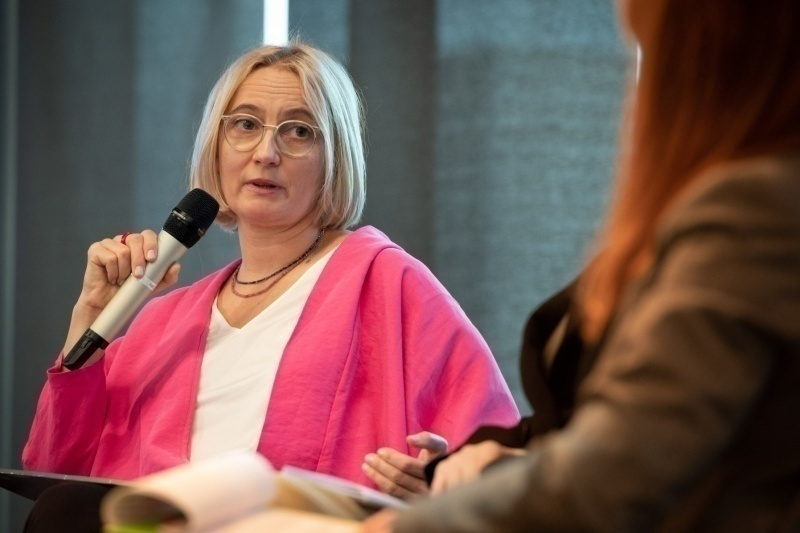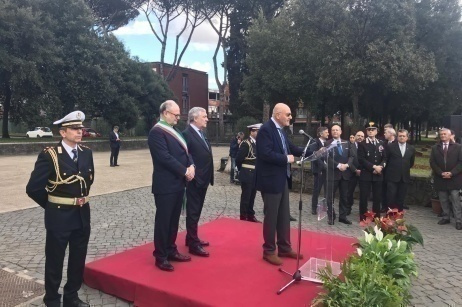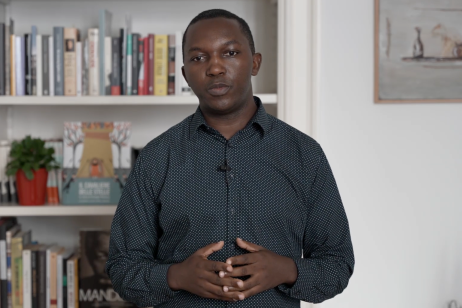We share below the speech given by Anna Ziarkowska, President of the Warsaw Garden of the Righteous Foundation, at the University of Seoul (South Korea) on November 23, 2023. The purpose of Anna Ziarkowska's presentation is to showcase the institutional dimension of the Garden of the Righteous as the only place in Poland commemorating individuals representing a broad spectrum of historical experiences, including the Armenian genocide, Holodomor, Holocaust, Nazism and Communist totalitarianism, the Rwandan genocide, Srebrenica massacre. The category of the Righteous extends to all those who, in extremely adverse times, advocated for justice and stood on the side of the victims. Located in a symbolic place within the former Warsaw Ghetto, the Garden serves as a memorial space, an educational tool, and a recreational area for the local community within a city park. To concretize the idea and understanding of the category of the Righteous, profiles of individuals previously honored with this title will be presented.
-------------------------------------------------------------------------------------------------
I would like to thank you very much for inviting me to today's conference. I will be speaking about the Garden of the Righteous in Warsaw, not from the perspective of a researcher, but as the curator of this project involved in its creation.
To give you an idea of where the Garden of the Righteous is located in Warsaw, I will use a well-known wartime photograph in which we can see the tower of Saint Augustine's Church and the sea of rubble on the site of the ghetto.
In the photograph next to it, we see the Garden of the Righteous today, exactly 80 years after the outbreak of the Warsaw Ghetto Uprising. The juxtaposition of these two images encapsulates the message of this place being a symbol of the victory of life, just as the plants and trees that have grown on the post-war ruins are a symbol of rebirth. In this context, the Garden is first and foremost a place of stories not of evil, but of good. By evoking the stories of the Righteous, they are brought back to life. This way, as Foundation Committee member Wacław Oszajca said: "We are repaying a debt to these people that is unpayable because human life has no price. Therefore, we are not the ones honouring those who suffered and died for justice. It is they who honour us with their presence and heroism".
The Garden of the Righteous in Warsaw was created as a grassroots community initiative, inspired by the work of the Italian Gariwo Foundation. In our country, which experienced two totalitarian ideologies, the idea promoted by Gariwo of creating Gardens and honouring people who, in Europe and beyond - during Nazism and Communism, genocides, mass murders, crimes against humanity committed in the 20th and 21st centuries - saved people's lives or stood up for human freedom and dignity, found a lively resonance.
The group of people who signed the declaration in the European Parliament on 16 January 2012 in support of the establishment of the European Day of Remembrance for the Righteous included Polish MEP Professor Lena Kolarska-Bobińska. The determination of the circles that initiated this process led to the European Parliament establishing 6 March as the European Day of Remembrance for the Righteous on 10 May 2012.
On 6 March 2013, during the first celebrations of the European Day of Remembrance for the Righteous, a Committee composed of eminent personalities from the world of science and culture was formed at the History Meeting House in Warsaw, headed by the first non-communist Prime Minister of the Republic of Poland Tadeusz Mazowiecki. The Committee aimed to support educational projects promoting the attitudes of the Righteous and to build the Garden of the Righteous in Warsaw. In response to Prime Minister Tadeusz Mazowiecki's appeal, which appeared in the Polish press, the mayor of Warsaw's Wola district took the initiative to donate land for the construction of the Garden of the Righteous. In a letter to the Prime Minister, she wrote: "It will be a great honour for the Wola district that the Garden of the Righteous can be built here”.
It is important to emphasize the special role played at this initial stage by Prime Minister Mazowiecki, who, thanks to his authority, gathered around him a group of committed intellectuals, eminent figures from the world of culture and science, and a group of social activists supporting the work of the Committee.
The Garden of the Righteous in Warsaw was inaugurated in 2014, less than a year after Tadeusz Mazowiecki's death.
By the Committee's decision, Prime Minister Mazowiecki was among the first to be honoured in the newly established Garden. The title of Righteous was awarded to him for the role he played in the former Yugoslavia, where he served as Special Rapporteur of the United Nations Commission on Human Rights.
As Zbigniew Gluza - President of the KARTA Centre, who took over the honourable function of heading the Committee after Tadeusz Mazowiecki's death - noted, Mazowiecki became: "the embodiment of this idea in both dimensions: organizational - through his declaration of participation and ethical - through his attitude at critical moments in the 20th century".
The composition of the Committee, which selects the Righteous each year, is also important in terms of the nature of this initiative. Members of the Committee include Polish MEP Prof. Lena Kolarska-Bobińska, who, in the European Parliament, supported efforts to establish a European Day of Remembrance for the Righteous, and former Foreign Minister Prof. Adam Daniel Rotfeld. The composition of the Committee is also diverse in terms of worldview. Its members range from the Chief Rabbi of Poland to the Jesuit columnist Wacław Oszajca, the Catholic editor Zbigniew Nosowski and the Polish journalist of Jewish origin Konstanty Gebert. The president of the Polish Society of the Righteous Among the Nations also plays an active role in the work of the Committee. The Committee also includes the director of the POLIN Museum of the History of Polish Jews, which is a partner of the Garden of the Righteous and where concerts for the Righteous are organized every year, in which Polish Righteous Among the Nations also participate.
The Committee has adopted criteria it uses to select the Righteous. As Zbigniew Gluza notes: It is not about creating a pantheon, listing "all the worthy ones", but about selecting figures whose attitude - due to the context of events, and the nature of their deeds - achieves the status of a model, a point of reference for the collective consciousness. The Warsaw Committee, which is independent in its decisions on those to be honoured, has decided not to commemorate life stories, but deeds. Otherwise, we would be sinking into the abyss of vetting, unable to find anyone whose biography is flawless. This would be a road to nowhere since we are not pointing out angelic entities, but people (Garden of the Righteous in Warsaw, Warsaw 2022, pp. 9-10). Furthermore, unlike Gariwo, the Polish Committee has adopted the principle of honouring only the deceased.
The concern for the sustainability of the achievements to date in the field of commemoration and education, made possible by the social commitment of the members of the Garden of the Righteous Committee and the institutional support of the History Meeting House, was the impetus for strengthening the organizational dimension of the Garden of the Righteous initiative in Warsaw. This was supported both by the accumulated heritage and the need to ensure long-term continuity of the initiative, but most of all by the need to improve the administrative and organizational aspects of the activities undertaken, to raise the rank and prestige of the entire project (inter alia, by planning the modernization of the space of the Garden of the Righteous and making it an important place of remembrance both locally and internationally).
In 2023, on the tenth anniversary of the European Parliament's establishment of the European Day of Remembrance for the Righteous, the grassroots initiative took an institutionalized form, transforming into the Garden of the Righteous Foundation. It was made up of the Auschwitz-Birkenau Foundation and the Italian Gariwo Foundation. The Founders also included a member of the Committee, the international economist Józef Wancer, whose biography is entangled in the dramatic modes of history: he was born in the Gulag and 80% of his family members were killed in the ghettos and at Auschwitz.
On a local level, the Foundation works in close partnership with the Warsaw authorities and the History Meeting House. At this point, I would like to show a film in which Józef Wancer talks about his motivation for getting involved in commemorating the attitudes of the Righteous.
Drawing on the past achievements and the legacy of Gariwo, which for twenty years has nurtured the memory of the attitudes of the Righteous, and the Auschwitz-Birkenau Foundation, which recalls the darkest moment of the world's most recent history, the newly established Garden of the Righteous Foundation aims to commemorate and popularize the attitudes of the Righteous, and endeavors to democratize the world by supporting and carrying out educational activities that serve to build an atmosphere of tolerance, trust and respect towards people of different nationalities, genders, minorities, cultures and religions.
The Foundation takes care of the Garden of the Righteous in Warsaw, which has symbolic significance not only for Warsaw but above all for the history of the world. It is located on the site of the former Warsaw Ghetto, whose 400,000 inhabitants were brutally exterminated during World War II. Nearby is St Augustine's Church, which was the only church in the Warsaw Ghetto to survive the post-war conflagration and where Jews fleeing the Ghetto during World War II were given shelter. Close to the Garden, within the Warsaw Ghetto, there was also the largest orphanage for Jewish children run by Janusz Korczak during the war. On the same Dzielna Street, along which the Garden of the Righteous is located, there was the PAWIAK prison during the Second World War, which became a place of execution for about 100,000 Poles. People of Jewish descent, such as Janusz Korczak and Emanuel Ringelblum, were also held there, as well as people who gave aid to the Jewish population, including Irena Sendler. A few hundred meters away from the Garden, in the basement of a house at 68 Nowolipki Street, was where the Ringelblum Archive was hidden.
So far, 36 people have been honoured in the Garden of the Righteous in Warsaw: Władysław Bartoszewski (2014), Magdalena Grodzka-Gużkowska (2014), Jan Karski (2014), Antonia Locatelli (2014), Tadeusz Mazowiecki (2014), Anna Politkowska (2014), Petro Hryhorenko (2015), Nelson Mandela (2015), Hasan Mazhar (2015), Władysław Bartoszewski (2016), Witold Pilecki (2016), Jan Zieja (2016), Natalia Gorbaniewska (2017), Jan Jelinek (2017), Roberto Kozak (2017), Rafal Lemkin (2018), Armin Wegner (2018), Adalbert Wojciech Zink (2018), Ewelina Lipko-Lipczynska (2019), Arseni Roginski (2019), Raoul Wallenberg (2019), Karol Modzelewski (2020), Stanislav Petrov (2020), Antonina Wyrzykowska (2020), Hrant Dink (2021), Julia Ilisinska (2021), Emanuel Ringelblum (2021), Liu Xiaobo (2021), Moshe Bejski (2022), Bronisław Geremek (2022), Wilhelm Hosenfeld (2022), Antonina and Jan Żabiński (2022), Gareth Jones (2023), Sergei Adamovich Kovalev (2023), Alfreda Markowska (2023).
Eleven of them have previously been honoured with the Righteous Among the Nations title: Magdalena Grodzka-Gużkowska, Jan Karski, Władysław Bartoszewski, Jan Jelinek, Armin Wegner, Ewelina Lipko-Lipczyńska, Raoul Wallenberg, Antonina Wyrzykowska, Wilhelm Hosenfeld, Antonina and Jan Żabiński. They account for 30% of all those honoured between 2014 and 2023. Nearly 45% of those honoured represent World War II experience, followed by dissidents, who account for 20% of those honoured. This is followed by those with experiences such as the Armenian genocide (5.5%), the Srebrenica massacre (3%), and the Rwandan genocide (3%).
Poles account for 36% of those honoured in the Garden.
A tree is planted for each person honoured. So far, three species of trees have been planted: apple trees, birch trees and cherry trees. In addition, each commemorated person has his or her commemorative stone, which bears an inscription justifying the choice made by the Committee.
I would like to present the three inscriptions of those honoured this year:
Alfreda Markowska (1926-2021)
a Polish Romani woman from a German murdered stock who saved 50 Roma, Jewish and German children. She didn't know how not to save - she didn't know it was heroism.
Gareth Jones (1905-1935)
a Welsh reporter who saw the Stalinist genocide of the Great Famine in Ukraine. He had the courage - against the lies of the press - to tell the world the truth about what he saw.
Sergey Adamovich Kovalev (1930-2021)
dissident and ombudsman who - measuring himself against Soviet and Russian state terrorism - successfully defended individual rights.
One of the tasks of the newly established Foundation is the modernization of the Garden's space, which we would like to realize in the coming year, which marks the Garden's tenth anniversary. The conceptual design has been prepared for us by one of Poland's most successful architects, Paweł Grobelny, author of many designs for public spaces. His realizations include the Zhongshan Garden in Shanghai, the Albertine Garden in Brussels, the La Defense business district in Paris, the EU district in Strasbourg, and the Rath Gyorgy Garden in Budapest.
The most important challenge faced by the designer was to combine the two functions of the Garden of the Righteous: a place of commemoration and education and a place of rest and recreation for residents.
The development project of the Garden consists of two main and complementary elements. The most important is a circle with a diameter of 10 m, which has an integrative function and can serve as a place for educational activities (agora). In the centre of the circle is a micro-garden, which also plays a symbolic role. The pot of this micro-garden is made of 15 stone blocks on which the values of the Garden of the Righteous are written: freedom, dignity, responsibility, etc. These values can be a pretext for starting educational activities in the circle. Children and young people can read each value out loud and discuss how they understand the value.
As I mentioned, the Garden of the Righteous is located on the site of the former Warsaw Ghetto. One of the elements closely referring to this place is the inner micro-garden with flowers in the centre of the circle. In works devoted to the history of the ghetto, one can find a lot of information about the lack of greenery there. Descriptions include phrases such as: "small islands of nature" or "nature deficit syndrome". There were hardly any green areas in the ghetto. However, the Jewish administration of the district sought to green it. This task was entrusted to the Society for the Promotion of Agriculture (Toporol), which was to take care of the creation of herbariums, flowerbeds and gardens for children. Despite the efforts made, greenery in the ghetto was something very rare. Among other things, the Society took care of the garden at the Main Shelter House at 37 Dzielna Street, not far from the Garden of the Righteous. Designed by Paweł Grobelny, the indoor micro-garden with ornamental flowers refers directly to the 'small islands of nature' described in the activities of the Society for the Advancement of Agriculture. It is also a micro-space that will need to be nurtured and therefore remembered and cared for.
This kind of environmental commemoration can be seen as a reparation for the ecosystems destroyed during the war and a reminder of the traumatic human experience.
The Gardens of the Righteous are a living metaphor for rebirth. Both the Milan and Warsaw gardens were built on the rubble of war, bringing hope and the victory of life. Like the Japanese hibakujumoku trees that survived the atomic bombings of Hiroshima and Nagasaki.
Unlike a memorial, which evokes the pain and suffering of the victims, the Garden of the Righteous conveys the beauty of the human person, bringing the actions of those commemorated out of oblivion and making their deeds public. The originality of the initiative lies in creating democratic participation in the selection of the Righteous. Anyone can nominate a person to be commemorated in the Garden and send the candidature to the Committee.
The main area of the Foundation's activities is education. According to research carried out in Poland, awareness of the Holocaust among Polish youth is growing year by year; issues relating to other types of genocide have not yet been studied. History textbooks, although they contain a considerable amount of knowledge about the Holocaust, do not inform young people about contemporary disputes about Polish historical memory. Polish school pupils are therefore not confronted with the question: what meaning does this history have for them?
In such a situation, we should therefore ask ourselves whether and to what extent the Polish school influences the building and strengthening of positive attitudes, such as tolerance, openness, and respect for other cultures. The set of figures that inspire pride in pupils is dominated by soldiers, their commanders and political leaders. The history of the Second World War is viewed by pupils from the perspective of battles, skirmishes, war campaigns, fronts, and uprisings. So how do we influence young people to be more open-minded? These are the questions facing the Garden of the Righteous Foundation. It seems that a key role in this process is played by teachers, who need appropriate support on a systemic level, but also cooperation with NGOs dealing with human rights issues and counteracting all kinds of discrimination.
From my personal experience over the years, I have learned that exposing the figures of the Righteous in the universalist perspective proposed by Gabriele Nissim fosters attitudes of openness and tolerance, as well as empathy for the sufferings and wrongs of other nations. To date, all Polish history textbooks use the term "Righteous" only in reference to one category of people, i.e. those who saved Jews. It is therefore unequivocally associated only with the Holocaust. As a result, Polish students do not learn much about positive role models and examples to follow. Among those most often discussed are the stories of Irena Sendler, the Ulma family, Raul Wallenberg and Oskar Schindler. Concerning people resisting the communist system, the names of Cardinal Stefan Wyszyński, Jacek Kuroń and Lech Wałęsa appear. Besides, Polish textbooks more often talk about collective rather than individual attitudes.
So why is it worth recalling the stories of the Righteous?
Władysław Bartoszewski, in his essay What do the Righteous teach their contemporaries? answers this question in the following way: "Civil courage, the ability to oppose hypocrisy and confusion. (...) For human solidarity is always valid, regardless of the political or historical situation. (...) The imperative to be vigilant against evil is an imperative both for believers and for those who profess their moral order".








